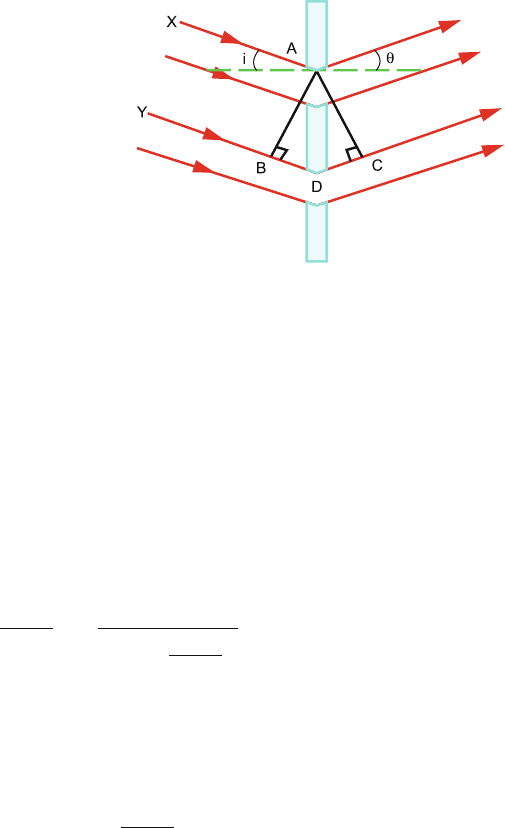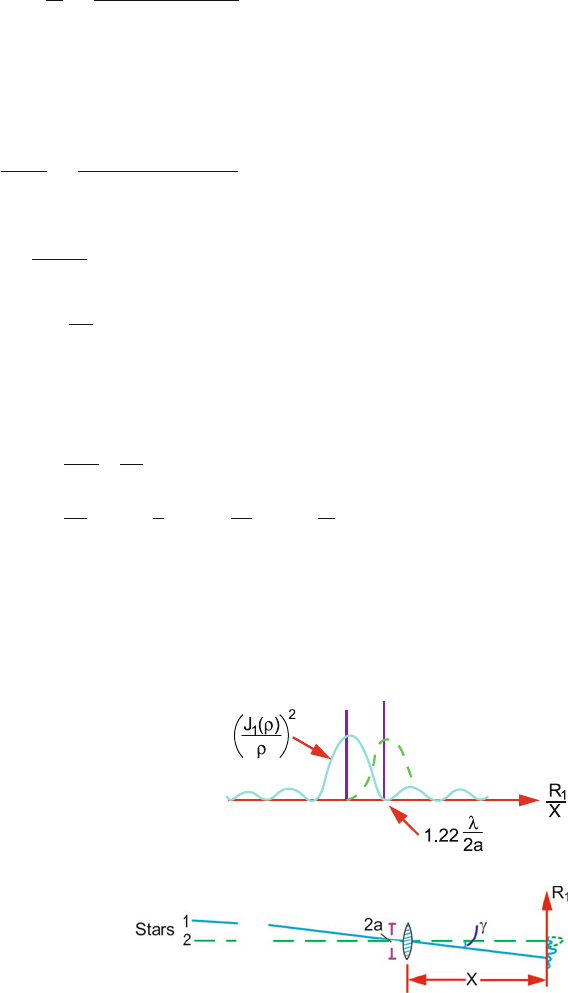Kamal A.A. 1000 Solved Problems in Classical Physics: An Exercise Book
Подождите немного. Документ загружается.


750 15 Optics
15.35 2μt cos r =
m +
1
2
λ (maxima), m = 0, 1, 2 ...
r = 0,μ= 1
λ =
2t
m +
1
2
=
2 × (2945 Å)
m +
1
2
=
5890
m +
1
2
Å
For m = 0,λ= 11,980 Å
m = 1,λ= 3927 Å
m = 2,λ= 2356 Å
λ = 3927 Å falls within the range of visible spectrum. The colour is violet.
15.36 2μt cos r =
m +
1
2
λ
r = 0, m = 0
t = λ/4μ
15.37 For constructive interference
2μt cos r =
m +
1
2
λ, m = 0, 1, 2 ...
sin r =
sin i
μ
=
sin 30
◦
1.5
= 0.3333
∴ cos r = 0.9428
λ =
2μt cos r
m +
1
2
=
2 × 1.5 × 4 × 10
−5
× 0.9428
m +
1
2
cm
For m = 1, we find λ = 7.542 × 10
−5
cm = 7542 Å.
15.38 (a) The two mirrors M
1
and M
2
are adjusted such that their distance from
the beam splitter are approximately equal, Fig. 15.4. The wavelengths
λ
1
and λ
2
for the D
1
and D
2
lines of sodium differ only by a few
angstroms. Two different sets of fringes arise due to two wavelengths.
If M
1
is slowly moved away there is a gradual separation of the two
sets, and finally the bright band of the one lies over the dark band of
the other, resulting in uniform illumination. Thus the fringes disappear
and reappear periodically. Between two successive disappearances the
mirror has to be moved by, say d cm. This corresponds to a path differ-
ence of 2d cm. Assuming that λ
2
<λ
1
, this path difference must contain
exactly one more wavelength of λ
2
than of λ
1
. Thus expressing λ
1
and
λ
2
in cm,

15.3 Solutions 751
2d
λ
2
−
2d
λ
1
= 1
∴ λ
1
− λ
2
= λ =
λ
1
λ
2
2d
(b) λ =
(5.89 × 10
−5
)
2
2 × 2.89 × 10
−5
= 6Å
15.39 λ =
2d
N
=
2 × 2.948 × 10
−3
cm
100
= 5.896 ×10
−5
cm = 5896 Å
15.40 Resolving power
λ
λ
=
gπ D
λ
where D = distance between the plates = 2mm= 0.2cm:
λ = 600 nm = 6 × 10
−5
cm
g =
2r
1 −r
2
=
2 × 0.9
1 − (0.9)
2
= 9.4737
R. P =
λ
λ
=
9.4737 × 3.14 × 0.2
6 × 10
−5
= 9.9 ×10
4
15.3.5 Diffraction
15.41
a sin θ = mλ (1)
∴ sin θ =
mλ
a
= 1 ×
λ
a
=
λ
a
(2)
If D is the slit screen distance and x the distance of the first minimum from
the central maximum, then
tan θ sin θ = x/D (3)
Combining (2) and (3)
λ =
ax
D
=
0.02 × 0.5
200
= 5 ×10
−5
cm = 5000 Å
15.42 I
θ
= I
m
sin α
α
2
Differentiating I
θ
with respect to α and setting
dI
θ
dα
= 0,
dI
θ
dα
=
I
m
(2α
2
sin α cos α − 2α sin
2
α)
α
4
= 0

752 15 Optics
∴ 2α sin α(α cos α − sin α) = 0
∴ tan α = α
15.43
(a) The half-width is the angle between the two points in the pattern where
the intensity is one-half the centre of the pattern:
I
θ
I
m
=
1
2
=
sin α
x
α
x
2
(1)
The solution of (1) found by numerical method is
α
x
= 1.40 rad (2)
α
x
=
πa
λ
sin θ
x
= 1.40 (3)
where θ
x
=
1
2
θ.
sin θ
x
=
1.4λ
πa
or θ
x
= sin
−1
1.4λ
πa
or θ = 2θ
x
= 2sin
−1
1.4λ
πa
(b) θ = 2sin
−1
1.4
4π
= 12.8
◦
15.44
a sin θ = mλ
a sin θ
1
= 1 ·λ
1
a sin θ
2
= 2λ
2
But θ
1
= θ
2
∴ λ
1
= 2λ
2
15.45
sin θ =
x
D
=
nλ
a
∴ a =
nλD
x
=
2 × 5.6 × 10
−5
× 200
1.6
= 0.014 cm
= 0.14 mm.
15.46
(a) Let m be the order of interference. If the slit width a is maintained con-
stant and the separation of the slits d is varied, the scale of the interfer-
ence pattern varies, but that of the diffraction pattern remains unchanged.
If the diffraction angle corresponds to the minimum given by (1) then a
particular order of interference maxima may be absent. This is called a

15.3 Solutions 753
missing order. Thus, a missing order is realized for an angle θ for which
the following two equations are simultaneously satisfied:
d sin θ = mλ(m = 1, 2, 3 ...) (1)
a sin θ = nλ(n = 1, 2, 3 ...) (2)
Dividing (1) by (2)
d
a
=
m
n
(3)
Since m and n are both integers, missing orders will occur when d/a is
in the ratio of two integers. Expressing d as the sum of the slit width a
and the opaque space b between consecutive slits, that is
d = a + b (4)
(3) an be written as
a + b
a
=
m
n
(5)
In particular, if
a+b
a
= 1, b = 0. In this case t he first-order spectrum
will be absent and the resultant diffraction pattern will be similar to that
of a single slit.
If
a+b
a
= 2, a = b, that is the width of the slit is equal to the width of
the opaque space. Here the second-order spectrum will be absent.
(b)
a + b
a
=
m
n
0.16 + 0.8
0.16
= 6 =
m
n
The above relation is satisfied for
n = 1, 2, 3,...
m = 6, 12, 18,...
Thus the order 6, 12, 18, etc. of the interference maxima will be missing,
in the diffraction pattern.
15.47 The central diffraction peak is limited by the first minima. The angular loca-
tions of these minima are given by
a sin θ = λ(∵ m = 1) (1)

754 15 Optics
The angular locations of the bright interference fringes are given by
d sin θ = mλ(m = 0, 1, 2 ...) (2)
We can locate the first diffraction minimum within the double-slit fringe pat-
tern by dividing (2) by (1)
n =
d
a
n =
0.2
0.012
= 16.66
Therefore 16 interference fringes will lie within the central maximum.
15.48 m
1
λ
1
= m
2
λ
2
λ
1
=
m
2
λ
2
m
1
=
3
4
× 5460 = 4095 Å
15.49 d sin θ = mλ
For m = m
max
,θ = θ
max
= 90
◦
, Given
1
d
= 5000
m
max
=
d
λ
=
1
5000
×
1
6 × 10
−5
= 3.33
∴ m
max
= 3
15.50
d
a
=
m
n
(condition for missing orders)
0.3
0.1
=
3
1
=
m
n
where m and n are integers. The above relation is satisfied for
m = 3, 6, 9
n = 1, 2, 3
Thus the maxima will be missing in the third, sixth, ninth, etc. orders.
15.51
d
a
=
a + b
a
=
a + 2a
a
= 3 =
m
n
The above relation is satisfied for
m = 3, 6, 9,...
n = 1, 2, 3,...

15.3 Solutions 755
Thus the interference maxima will be missing in the third, sixth, ninth, etc.
orders.
15.52
n
1
(max) =
d
λ
1
=
1
Nλ
1
=
1
4000 × 4 × 10
−5
= 6.25
n
2
(max) =
d
λ
2
=
1
Nλ
2
=
1
4000 × 7 × 10
−5
= 3.57
The maximum order of spectrum varies between 3 (towards red) and 6
(towards violet).
15.53
d
a
=
a + b
a
=
a + a
a
= 2 =
m
n
(condition for missing orders)
∴ m = 2n
The above condition is satisfied for
n = 1, 2, 3 ...
m = 2, 4, 6 ...
Thus all the even orders of interference fringes (2, 4, 6, ...), except m = 0,
are missing.
15.54 The secondary maxima lie approximately halfway between the minima.
Now, the intensity at an angle θ is given by
I
θ
= I
m
sin α
α
2
(1)
where α =
π a
λ
sin θ (2)
Minima occur in (1) when
α = mπ(m = 1, 2, 3 ...) (3)
Therefore the first secondary maximum would occur halfway between first
minimum and second minimum. Therefore,
α =
m +
1
2
π =
3 π
2
(4)
Substituting (4) into (1)
I
I
m
=
sin(3π/2)
3πl2
2
= 0.045 or 4.5%

756 15 Optics
15.55 In Fig. 15.34 the grating space AD = d.IntheABD, B
ˆ
AD = i, the angle
of incidence. Also D
ˆ
AC = θ, the angle of diffraction. In the ABD, BD the
path difference between the incident rays, YD and XA is
BD = d sin i
Fig. 15.34 Diffractionbya
grating for a parallel beam of
light which is obliquely
incident
Similarly, the path difference between the diffracted rays is
DC = d sin θ
The total path difference
BD + DC = d(sin i +sin θ) (1)
For the mth primary maximum
d(sin θ
m
+ sin i) = mλ (2)
or sin
θ
m
+i
2
=
mλ
2d cos
θ
m
−i
2
(3)
The angle of deviation of the diffracted beam is
δ
m
= θ
m
+i (4)
For δ
m
to be minimum, cos
θ
m
−i
2
must be maximum, that is
(θ
m
−i)/2 = 0 → θ
m
= i (5)

15.3 Solutions 757
Then δ
m
will be minimum, say D
m
, and is given by
D
m
= θ
m
+i = 2i
or i = D
m
/2(6)
Substituting (5) and (6) into (3)
2d sin
D
m
2
= mλ (7)
N =
1
d
=
2sin(20/2)
1 × 4.358 × 10
−5
= 7969 lines/cm
15.56 Condition for overlapping is
mλ
1
= (m + 1)λ
2
5400 m = 4050 × (m + 1)
∴ m = 3
d sin θ = mλ
1
N =
1
d
=
sin θ
mλ
1
=
sin 30
◦
3 × 5.4 × 10
−5
= 3086 lines/cm
15.57
λ = 5893 Å = 5.893 × 10
−5
cm
λ = λ
1
− λ
2
= 5896 −5890 = 6Å= 6 × 10
−8
cm
Resolving power
R =
λ
dλ
=
5.893 × 10
−5
6 × 10
−8
= 982
R = Nm
∴ N =
R
m
=
982
2
= 491 (Total number of lines)
If N
is the number of lines/cm, then the width of the grating
W =
N
N
=
491
800
= 0.614 cm
15.58 Total number of lines on the grating
N = N
W (1)

758 15 Optics
where N
= number of lines/in. and W is the grating width (in inch)
∴ N = 10, 000 ×3 = 30, 000
R =
λ
dλ
= Nm
∴ dλ =
λ
Nm
=
6 × 10
−5
3 × 10
4
× 1
= 2 ×10
−9
cm = 0.2Å
15.59 Total number of lines
N = N
W = 2 ×425 = 850
λ = 5893 Å, dλ = 5896 −5890 = 6Å
(i) First order:
R =
λ
dλ
= Nm
N =
1
m
λ
dλ
=
1
1
×
5893
6
= 982 lines
As the required number of lines (982) exceeds the total number of lines
(850) the lines are not resolved in the first order.
(ii) Second order
N =
1
m
λ
dλ
=
1
2
×
5893
6
= 491
As the required number of lines (491) is less than the total number of
lines, the lines are resolved in the second order.
15.60 The resolving power for a prism of base length B is given by
R =
λ
λ
=
Bdμ
dλ
(1)
where dμ/dλ is the variation of refraction index of the prism with wave-
length, λ is the mean wavelength and λ is the difference in wavelengths to
be resolved:
λ = 5893 Å,λ = 5896 − 5890 = 6Å
dμ
dλ
=
1.6635 − 1.6545
(6563 − 5270) × 10
−8
cm
= 696/ cm
Substituting the above values in (1) and solving for B, we find the length of
the base of the prism, B = 1.41cm.

15.3 Solutions 759
15.61 The limit of resolution of a telescope is
dθ = 1.22
λ
D
=
1.22 × 55 × 10
−5
500
= 1.342 ×10
−7
rad
If the distance between two points is x and the moon–earth distance r, then
x = r dθ = 3.8 × 10
8
× 1.342 × 10
−7
m = 51 m
15.62 θ =
1.22λ
d
=
1.22 × 5.89 × 10
−7
30 × 10
−6
= 0.024 rad
15.63 I = I
0
2J
1
(ρ)
ρ
2
where ρ =
2π
λ
a sin θ and J
1
(ρ) is the Bessel function of the first kind.
According to the Rayleigh criterion, the separation of the peaks is equal to the
distance between the first minimum and the centre of the diffraction pattern,
that is, the first minimum of the Bessel function is at ρ = 3.83, and we have
ρ = 3.83 =
2πa
λ
R
1
X
or γ =
R
1
X
= 0.61
λ
a
= 1.22
λ
2a
= 1.22
λ
D
where 2a = D is the diameter of the lens, γ is the angle between the two
stars, the distance between the observation screen and the lens is X (equal
to focal length of the lens) and the position of the details of the diffraction
pattern is R
1
,Fig.15.35a, b.
Fig. 15.35 a Intensity
distribution for diffraction
from a circular aperture
described by Bessel function
Fig. 15.35 b Resolution of
diffraction patterns for two
stars, the angle between them
being γ . For the explanation
of parameters X, R
1
and ρ,
see the text
